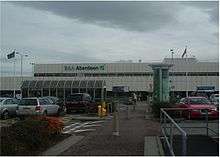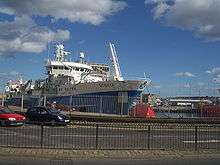Transport in Aberdeen
The network of transportation in Aberdeen is widespread and complex like that of any major city. It is currently receiving the attention of politicians in Scotland who have acknowledged that there has been underinvestment over the past few decades in keeping the infrastructure in line with the needs of the city.
As an ancient city, Aberdeen has some beautiful infrastructure feature such as the Brig o' Balgownie and the Bridge of Dee. Like any other city, the advent of cars has however seen the creation of less beautiful infrastructure such as the Anderson Drive dual carriageway and the Haudagain Roundabout which sees constant tailbacks.
Airport and heliport

Aberdeen Airport, in the neighbouring town of Dyce, serves primarily UK and European destinations for passenger and freight flights. It is also the busiest helicopter terminal in the world,[1] serving the many North Sea oil offshore installations. Via commercial airlines, connections are available via London Heathrow, Paris-Charles de Gaulle, Frankfurt and Amsterdam airports to many worldwide destinations. The IATA airport code for the airport is ABZ. A regular airport bus service (route 727 operated by Stagecoach Bluebird) connects the airport directly with the city centre at Broad Street and the bus and railway stations at Union Square.
Railway

Historical
Aberdeen was connected to the railway network from the south with the opening of Aberdeen Ferryhill railway station in 1850. Three years later, the Deeside Railway opened and the following year the railway was extended to Guild Street. From the north, the Great North of Scotland Railway opened its terminus at Kittybrewster in 1854. A new terminus, Aberdeen Waterloo, opened two years later. The two railways weren't connected until 1967 when the Joint station opened at the site of the present day Aberdeen railway station.
As with many parts of the UK rail network, several lines out of Aberdeen were closed in the 1960s. For example, the Deeside Railway which ran west of the city to Ballater opened in 1853 but the Beeching Report led to the closure of the line in 1966. The line is now a popular walk and cycle route, the Deeside Way. Further lines running north to the commuter town of Ellon and to Peterhead were also closed around this time.
Present day
There are two railway stations in Aberdeen. The main city-centre station is located on Guild Street, adjacent to Union Square which offers a covered interchange with the bus station. The only other station in Aberdeen City is Dyce to the north.
Abellio ScotRail services connect Aberdeen to all six other Scottish cities, including Edinburgh and Glasgow, and many intermediate destinations. These services make use of the Glasgow to Aberdeen Line, Edinburgh to Aberdeen line and Aberdeen to Inverness Line. High-speed inter-city services operated by London North Eastern Railway connect Aberdeen to London via Edinburgh in just over seven hours on the East Coast Main Line. A regular stopping service, also run by ScotRail, serves Aberdeen along with all stations between Inverurie and Montrose. Inter-city services operated by CrossCountry connect Aberdeen to south-west England and numerous intermediate destinations such as Sheffield, Birmingham, Bristol and Exeter. In addition, the Caledonian Sleeper service makes an overnight journey to/from London Euston six days a week.
Buses
Bus services form the main public transportation system in Aberdeen. Most city buses are operated privately by FirstGroup via their subsidiary First Aberdeen (First's global headquarters are located in the city, on King Street). First Aberdeen has a monopoly on city bus services in Aberdeen partly due to their history. When bus services in the UK were privatised in the 1980s, those in Aberdeen were the subject of a management buy-out. The resulting company developed into FirstGroup following a number of mergers and acquisitions over the years. First Aberdeen has been criticised by local politicians and in the media for taking advantage of its monopoly with high fares and mediocre service.[2] The company has defended its frequent fare rises as being necessary due to high running costs and cuts to government subsidies.[3]
First Aberdeen have the largest share of routes in the city with 22 services currently running. They operate a hub-and-spoke network - the majority of routes begin at an outskirt or suburb, run through the city centre (often via at least part of Union Street) and then out to another suburb. For example, route 1 runs from Danestone in the north, to the city centre along Union Street, then out to Garthdee in the south-west. Services run at intervals from approximately every 15 minutes (during the day) to every 30 minutes (in the evening and on Sundays). All First Aberdeen buses require the exact fare as none carry change. Many of the routes date back to those formerly operated by trams. When the tram system was closed in the 1950s, the same routes were replaced by diesel buses. Many of these same routes, with minor alterations, still run today.
Stagecoach Bluebird also operate a single cross-city route; their route 59 operates between Northfield and Balnagask via the city centre and Aberdeen Royal Infirmary. Stagecoach Bluebird also operate a frequent service linking the bus station at Union Square to Aberdeen Airport as route 727. Change is given on Stagecoach Bluebird services.
Country bus services to outlying and rural villages and towns are also operated by Stagecoach Bluebird. Most start and terminate at the bus station at Union Square. They also pick up passengers at stops in the city. Routes such as the Coast Rider, (running between Montrose; Stonehaven; Newtonhill; Portlethen and Aberdeen) are popular, especially during rush hour with commuters working in the city.
Longer-distance and inter-city buses operate from the bus station at Union Square. Frequent services to other Scottish cities are operated by Scottish Citylink and Megabus, including the luxury Citylink Gold service to/from Glasgow. National Express operates services to/from London via a number of towns and cities as well as Heathrow Airport.
Roads
There are six main roads into and out of the city:
- The A92 runs north to the Blackdog interchange, where it joins the A90 for Ellon, Peterhead and Fraserburgh.
- The A947 exits the city at Dyce and goes on to Oldmeldrum and Turriff, ending at Banff.
- The A96 links to Elgin and Inverness in the north-west, passing through Inverurie, Huntly and Keith.
- The A944 exits the city to the west, passing through Westhill before following Donside to Alford, Strathdon and Corgarff.
- The A93 follows Deeside west to Banchory, Aboyne, Ballater and Braemar, then turns south, providing an alternative tourist route to Perth.
- The A92 south joins the A90 at Stonehaven, then continues as the coastal route by Inverbervie, Montrose and Arbroath to Dundee and on into Fife, whilst the A90 from Stonehaven provides the primary route to Dundee, Perth and Edinburgh.
The A90 Aberdeen Western Peripheral Route opened in stages during 2018 and 2019 and provides a bypass around the city from Blackdog in the north to Stonehaven in the south, diverting traffic away from the city centre and from the city's original ring road, Anderson Drive, built in the 1930s.
Bridges
Aberdeen's two main rivers, the Dee and Don are currently crossed by a variety of bridges, varying from modern structures to older stone bridges dating back hundreds of years.
River Dee crossings
The River Dee is crossed by a number of bridges, from east to west:
- Victoria Bridge
- Queen Elizabeth Bridge
- Wellington Suspension Bridge
- Railway bridge
- King George VI Bridge
- Bridge of Dee
- St Devenick's Bridge
- Maryculter Bridge
Maryculter Bridge links the North and South Deeside roads near the village of Maryculter close to the boundary of the council area, the bridge is earmarked for expansion as part of the proposed Aberdeen Western Peripheral Route to bypass the city.
Victoria Bridge was completed in 1887, following a ferry disaster in 1876 which claimed the lives of 32 people returning from a visit to the Bay of Nigg.[4] It was made possible by the 1871 channelling of the River Dee which had previously followed an unstable course to the sea. The bridge has facilities for carrying water and gas services across the river.
Queen Elizabeth II Bridge opened in 1983.
Wellington Suspension Bridge is very narrow and was designed by Captain Samuel Brown and opened in 1831 to replace the Craiglug ferry. Refurbished in 1930, the Category A listed building was closed to vehicular traffic in 1984 and to pedestrians in March 2002 due to structural concerns. However it was refurbished and re-opened as a pedestrian bridge in 2008.[5]
River Don crossings

The River Don is crossed by a number of bridges, from east to west:
- Bridge of Don
- Brig o' Balgownie
- Diamond Bridge
- Grandholm Bridge
- Persley Bridge
The Bridge of Don has five granite arches, each 75 ft (23 m) in span, and was built 1827-1832. A little to the west is the Auld Brig o' Balgownie, a picturesque single arch spanning the deep black stream, said to have been built by King Robert I, and celebrated by George Gordon Byron, 6th Baron Byron in the tenth canto of "Don Juan". It is closed to motor vehicles. The Grandholm Bridge is a private bridge, constructed for the Crombie Mills in the 1920s. Access to the bridge, other than for pedestrians and bicycles, is now controlled by an electronically activated barrier, passes for which are made available to residents of the housing development constructed on the site of the mills in 2004.
The A92 road uses Persley Bridge.
Sea

Aberdeen Harbour was the first publicly limited company in the United Kingdom and is today the principal commercial port in northern Scotland and an international port for general cargo, roll-on/roll-off and container traffic. The harbour also serves NorthLink Ferries, which sail to Kirkwall, Orkney and Lerwick, Shetland. The Aberdeen Maritime Museum (on Shiprow in the city centre) includes exhibitions and displays which tell the story of the harbour and its role in the economy and development of the city.
Originally, the defective harbour, with a shallow sand and gravel bar at its entrance, retarded the trade of Aberdeen, but under various acts since 1773 it was greatly deepened.
By the Harbour Act of 1868, the river Dee near the harbour was diverted from the south at a cost of £80,000, and 90 acres (364,000 m²) of new ground, in addition to 25 acres (101,000 m²) formerly made up, were provided on the north side of the river for the Albert Basin (with a graving dock), quays and warehouses. A 1050 ft (320 m) long concrete breakwater was constructed on the south side of the stream as a protection against south-easterly gales. On Girdleness, the southern point of the bay, a lighthouse was built in 1833.
The North Pier, built partly by John Smeaton 1775-81, and partly by Thomas Telford 1810-15, extends nearly 3,000 ft (1000 m) into the North Sea and raised the bar.
Victoria Dock, named in honour of the queen's visit to the city in that year, is a wet dock of 29 acres (117,000 m²) and with 6000 ft (1800 m) of quay, was completed in 1848
Upper Dock adjoins Victoria Dock.
Ferry services to the Northern Isles
NorthLink Ferries provides daily vehicle and foot-passenger service to Lerwick, Shetland, and regular service to Kirkwall, Orkney. On this route it operates two vessels, Hjaltland and Hrossey. These services arrive and depart at the ferry terminal which can be accessed off Market Street. The vessel can usually be clearly seen from the street when docked.
Trams
The last tram ran on 3 May 1958. All but one were then scrapped; the last is on display in the Grampian Transport Museum at Alford, Aberdeenshire.
See also
- Causey Mounth
- Green Spaces and Walkways in Aberdeen
References
- "Dyce has become home to the busiest heliport in the world". Aberdeen Journals. Retrieved 8 February 2013.
- http://www.pressandjournal.co.uk/Article.aspx/1361692 High bus fares prompt call for inquiry into monopoly
- "Archived copy". Archived from the original on 18 March 2012. Retrieved 14 May 2012.CS1 maint: archived copy as title (link) Bus firm 'forced' to increase fares
- W. Hamish Fraser and Clive H. Lee (2000). Aberdeen 1800-2000 A New History. Aberdeen: Tuckwell Press. Aberdeen City Council. ISBN 1-86232-108-6.
- http://www.pressandjournal.co.uk/Article.aspx/821154

